Physics for Electrical Engineering: Unit I: Dielectric Materials and Insulation
Gauss's law and Boundary condition
Definition, Statement, Formula, Applications, Uses, Classification, Types
Gauss's law is an important basic law in electrostatics.
GAUSS'S
LAW AND BOUNDARY CONDITION
Gauss's
law is an important basic law in electrostatics.
This law relates the electric flux
through any closed surface and net charge available inside the closed surface.
Statement
The
total electric flux of the electric field ![]() over any closed surface is
equal to1/ ε0 times the total charge enclosed by the surface.
over any closed surface is
equal to1/ ε0 times the total charge enclosed by the surface.
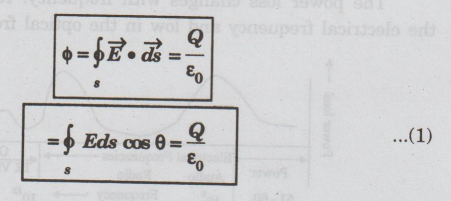
Explanation
Let
q be the net charge enclosed within a surface. This closed surface is known as
"Gaussian surface" and it is an imaginary surface (Fig. 1.14).
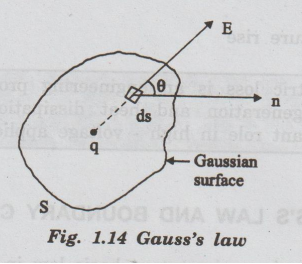
The
total electrical flux of ![]() through a closed surface 'S' depends only
on the value of the net charge inside the surface. The electric flux does
depend not on the location of the charges inside the closed surface.
through a closed surface 'S' depends only
on the value of the net charge inside the surface. The electric flux does
depend not on the location of the charges inside the closed surface.
The
charges outside the surface will not contribute to the flux. (ie., the flux
through the closed surface due to the charges present outside the closed
surface is zero).
Uses of Gauss's law
(i)
It is used to find the electric field by constructing a closed surface
(Gaussian surface).
(ii)Gauss's
law is one of the fundamental equations of electromagnetic theory. i.e., it is
one of the Maxwell's equations.
(iii)
The Coulomb's law can be derived from Gauss's law.
Applications of Gauss's law
It
is used to find electric field due to the given charge distributions.
Boundary Conditions
Consider
the field in the parallel plate capacitor in figure 1.15 with out dielectric
medium. A thin rectangular Gaussian surface is taken. This surface just
encloses the positive electrode that contains the free charges +Q0
on the plate.
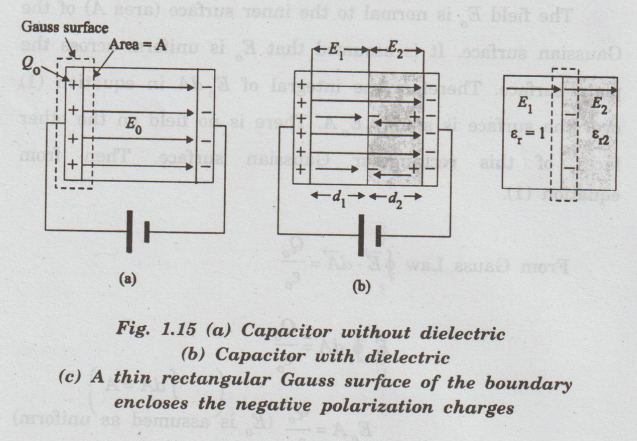
The
field E0 is normal to the inner surface (area A) of the Gaussian
surface. It is assumed that E0 is uniform across the plate surface.
Therefore the integral of En dA in equation (1) over the surface is
simply E0A. There is no field on the other faces of this rectangular
Gaussian equation (1).
From
Gauss Law
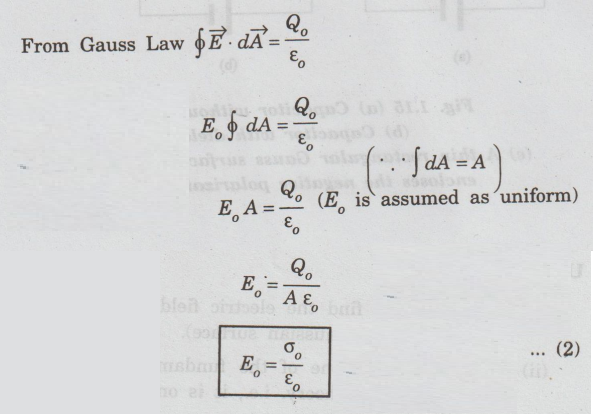
where,
σv = Q0 / A is the free surface charge density.
Now, let us consider that a dielectric slab partially fills the distance between the plates, as shown in figure 1.15(b).
The
applied voltage remains the same, but the field is no longer uniform between
the plates.
There
is an air-dielectric boundary. The field is different in the air and dielectric
regions.
Both
these fields are normal to the boundary by the choice of the dielectric shape
(faces parallel to the plates).
The
bound surface charges + A σP , and -A σP, appear on the
surfaces of the dielectric slab due to polarizatin as shown in figure 1.15. The
surface charge density (σp) due to induced charge is equal to the
polarization (P) in the dielectric. A very narrow rectangular Gaussian
From
Gauss law
E2
A- E1A =- A σP / ε0...(3)
where
E1 and E2 are electric field in air and dielectric
respectively - ve sign is due to negative induced change.
rearranging
eqn (3)
E1=E2+
P / ε0 ................(4)
(σp=P)
The
polarization P and the field E2 in the dielectric are related by
P=
ε0 Xe2E2
or
P = ε0 (εr2 -1) E2 ...(5)
where
Xe2 is the electrical susceptibility and εr2 permittivity
of the inserted dielectric. Substituting (5) in (4).
We
have
E1
= E2+ (εr2 -1) E2
E1
= E2+εr2 E2-E2
E1 = εr2 E2... (6)
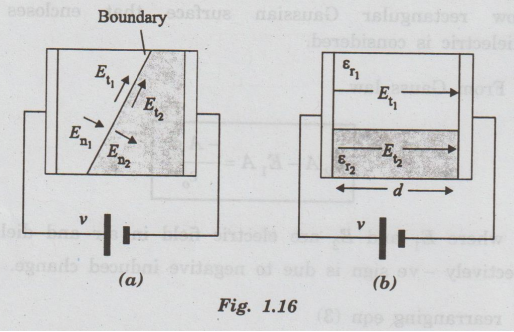
(a)
Boundary conditions between dielectrics
(b)
The case for Et1 = Et2
E1
= εr2, E2...(7)
The
field in the air part is E1 and the relative permittivity is1.
The
example in figure 1.15 involved is a boundary between air and a dielectric solid.
The boundary is parallel to the plates and hence normal to the fields E1
and E2.
A
general expression can be shown to relate the normal component of the electric
field, shown as En1 and E n2 in figure 1.16 on either
side of a boundary by
εr1
En1 = εr2 En2 ...(8)
There
is a second boundary condition that relates the tangential components of the
electric field, shown as Et1 and Et2 in figure 1.16(b),
on either side of a boundary. These tangential fields must be equal.
Et1
= Et2 ....(9)
The
above boundary conditions are widely used in explaining dielectric behavior
when boundaries are involved.
Classification of dielectric materials
Dielectric
materials are classified based on the physical state as
(i)
Solid dielectric materials
(ii)
Liquid dielectric materials
(iii)
Gaseous dielectric materials
Types of Dielectrics
Based
on the applications, there are two types of dielectric materials
(i)
Active dielectrics (Ferroelectrics, piezoelectrics and pyroelectrics)
(ii) Passive dielectrics (electrical insulating
materials)
Active dielectrics or Ferroelectric
materials
Active
dielectrics are the materials which are used to generate, amplify, modulate and
convert the electrical signals. They are used to store electrical energy.
Passive dielectrics (Insulating materials)
The
function of the insulating material is to obstruct the flow of electric
current.
Physics for Electrical Engineering: Unit I: Dielectric Materials and Insulation : Tag: : Definition, Statement, Formula, Applications, Uses, Classification, Types - Gauss's law and Boundary condition
Related Topics
Related Subjects
Physics for Electrical Engineering
PH3202 2nd Semester 2021 Regulation | 2nd Semester EEE Dept 2021 Regulation
